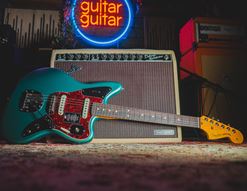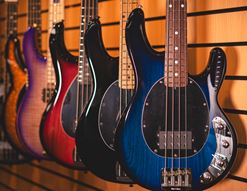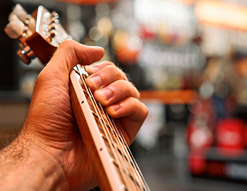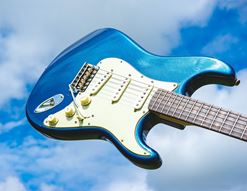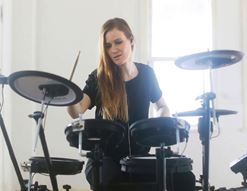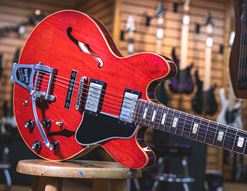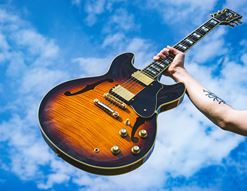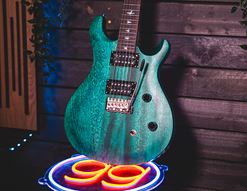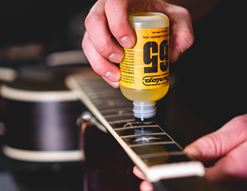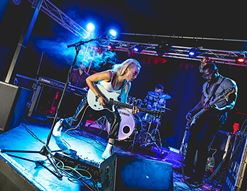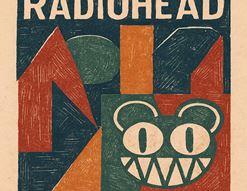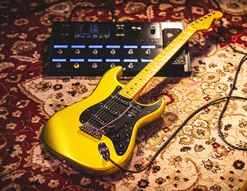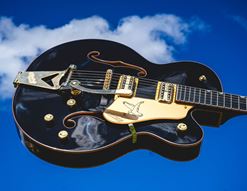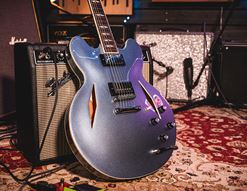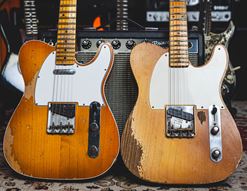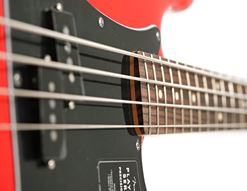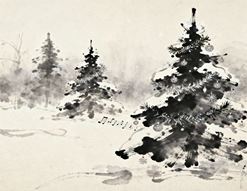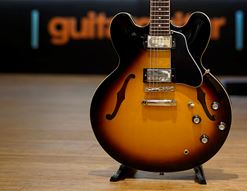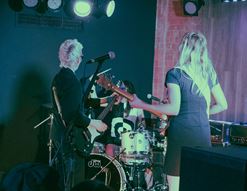Black Sabbath are the original metal band.
These Brummie dark lords - Ozzy Osbourne, Tony Iommi, Geezer Butler and Bill Ward - will be sharing a stage for the final time this summer, and it’s easily the biggest rock event of the year.
Did you manage to get a ticket? Lucky you! I bet you’re now constantly working your way through the band’s peerless back catalogue, taking in all of the gigantic riffs, buzzing tones and impermeable creepiness that Black Sabbath have offered up over the past 50+ years.
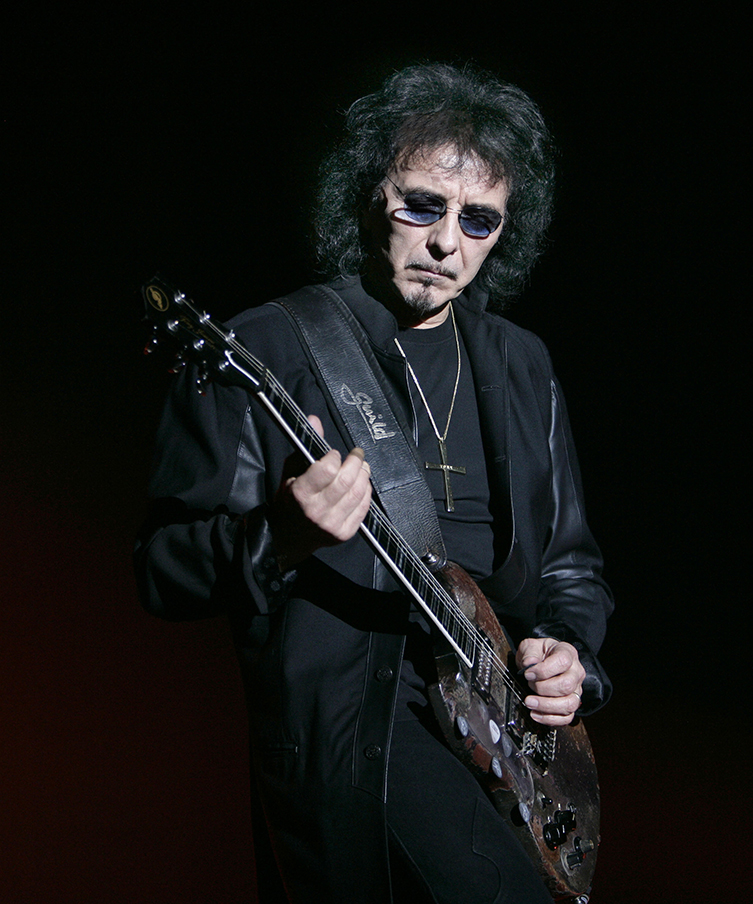
It’s an exceptional body of work, and a treasure trove for guitarists.
Tony Iommi is as unique a player as he is influential, and I wanted to take a few minutes today to share a couple of ways in which you can incorporate some of his devilish sound and attitude into your own playing.
So now, switch on your amp, draw a protective magic circle on the floor with chalk, and prepare to summon some otherworldly musical mayhem…
Contents
There’s Only One Black Sabbath
Tony Iommi’s Guitar Gear
- Gibson SG with either humbuckers or P90s
- 100w Laney valve stacks
- Treble Boost pedal
- Beelzebub (optional)
Tony Iommi’s sound has definitely changed over the years, but there’s a signature buzz and burn to his tones that can be heard again and again throughout. Like all great historical guitar sounds, Iommi’s tones rely on mic placement as much as anything else, so using your ears and applying EQ will always be more important than some of the more talked-about elements.
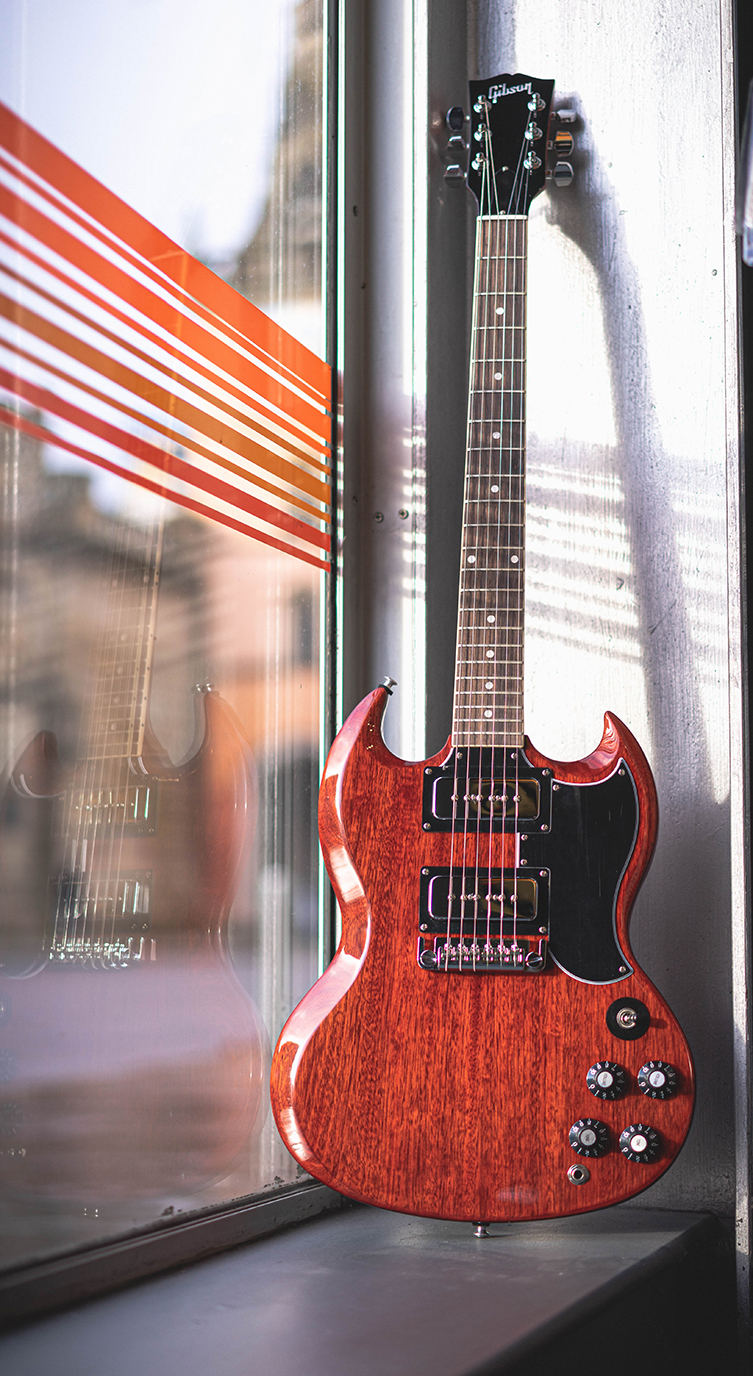
The Guitar
- SG-type guitars
- Gibson mainly, alongside custom Jaydee
- Epiphone options will definitely get you there, too
The Black Sabbath guitar is obviously a Gibson SG. Nowadays, Tony likes humbuckers on his SGs (and crucifix fretboard inlays, naturally) but a large amount of the classic stuff was recorded using a 1964 Gibson SG Special featuring single coil P90 pickups. Surprising perhaps, given the volume levels required to blast out his tones!
Tony has used custom Jaydee builds over the years too, so fans might recognise those. Largely though, it’s a Gibson affair, and there have been a few Tony Iommi signature guitars over the years from them and their sister brand Epiphone. In my opinion, I reckon a straight-up Ebony finish Gibson SG Standard is as ‘Iommi’ as it gets, and will bring you the vibe and sound you require!
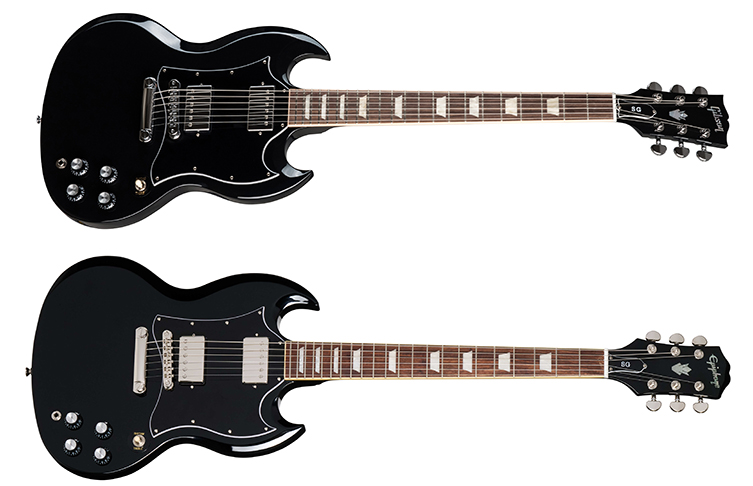
If you are running on a tighter budget, an equivalent Epiphone SG is absolutely the right way to go. In any case, I’d recommend sticking with passive pickups over active ones. This is perhaps more relevant if you decide on something like an LTD Viper or some other SG-style guitar, since lots of those come with EMGs and Fishman Fluences these days. Tony’s sound is heavy for sure, but it’s not ‘active heavy’. Passive is the way forward here, and not even particularly high output passives either, since the amp will be doing most of the work with these tones.
Speaking of which…
The Amplifier
- British valve amps for the win
- Laney are the particular favourites for Tony
- Go for headroom and volume, even when digitally modelling
For backline and recording, Iommi has almost exclusively used Laney amps throughout his career. The actual models have varied from Supergroup amps to the LA series, and I should probably add that there has been the odd Marshall in there, too! Large, old-school valve stacks are what to go for, with lots of headroom, so go for 100 watt EL34-valved heads over 50 watt heads if you can.

If you are getting your tones from digital modelling, my advice is to pay more attention to cab modelling, mic placement and IRs than to the actual amp model itself. I’ve often found success when imitating famous tones by using the ‘wrong’ amp models and simply trying different settings. Tony used 6 full-on 4x12 cabs too, so consider that when dialling in your virtual tones!

The Pedal
- Old-school boosts are the way for early tones
- Pay attention to frequencies more than gain
A significant part of the Black Sabbath sound (in those early records at any rate) is a treble booster. We don’t really talk about treble boosters much these days because amplifiers (and modelled amplifiers) all have much more front end gain available. Back in the mid to late 60s, guitarists needed volume in order to break up their sound, or else they had to use a fuzz pedal or treble booster. The Black Sabbath tone relies (in my opinion) much more on pushed, boosted tones than flat-out fuzz effects.
For example, the pedal used on a classic BS album like Volume 4 (a personal favourite, I have to say) was the Dallas Rangemaster. Apparently Tony’s pedal was modified too, which makes sense when you compare his tone to that of other Rangemaster users such as Rory Gallagher.
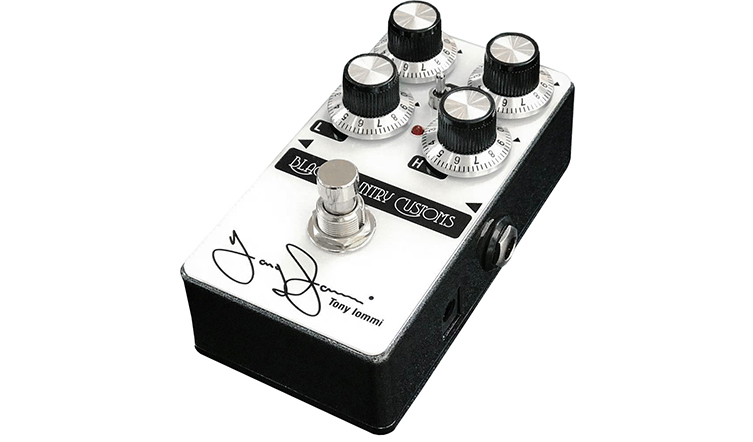
What was the mod? Nobody seems too sure, but Sabbath acolytes do talk about it being a ‘full frequency’ boost rather than simply a treble boost. My advice? Either go for Laney’s Black Country Custom TI Boost (Iommi's recent signature pedal) or once again get the EQ out and experiment with pushing frequencies rather than pulling them back. Your ears will tell you how close you’re getting more than your eyes!
So those are the main elements of Tony’s equipment setup, but there’s far more to the sound than just gear. Let’s keep going…
Guitar Tuning
- Get ready to tune low, to C#
- First two records are in E standard
Black Sabbath’s first couple of records were actually recorded in regular, straightforward E standard. By the time Master of Reality was being recorded in 1971 though, the tuning had dropped down a half step to Eb. By Volume 4, the band were down further again, to C#. That’s a full step/tone and a half down from standard, or three frets’ worth, if you prefer. Back in the early 70s! That’s pretty pioneering stuff!
The riffs just don’t sound right otherwise, as you’ll have found out yourself if you’ve ever tried to play stuff like Supernaut in regular E standard. It just doesn’t have that heft and evilness, as it were.
Now, you’ll be thinking that all of this downtuning means you’ll need to change your strings, right? You’re not wrong, but it may not be in the direction you’re thinking…
Guitar Strings
- Iommi uses very light strings
- You may not want to do that yourself
Common practice dictates that when you downtune your guitar a full tone and a half to C#, you compensate for the incurred lack of tension by using significantly heavier strings, right?
Not if you are Tony Iommi!
Remember folks, Tony’s fingertips were brutally chopped off in a factory accident, and he plays with plastic false digit-ends (the technical term is not forthcoming…), so his feel for the guitar is massively different from ours. I believe there is still (or was for a while, at any rate) a degree of pain involved when he is playing, too, so for those reasons, Tony tunes to C# AND he uses seriously light strings to take the strain off his injured hand.
I’m talking about gauge 8 here. Well, actually, I’m talking about gauge 8 for the D#/Eb stuff, and gauge 9 for all of the C# material. That is still crazy light considering how much each string is detuned!
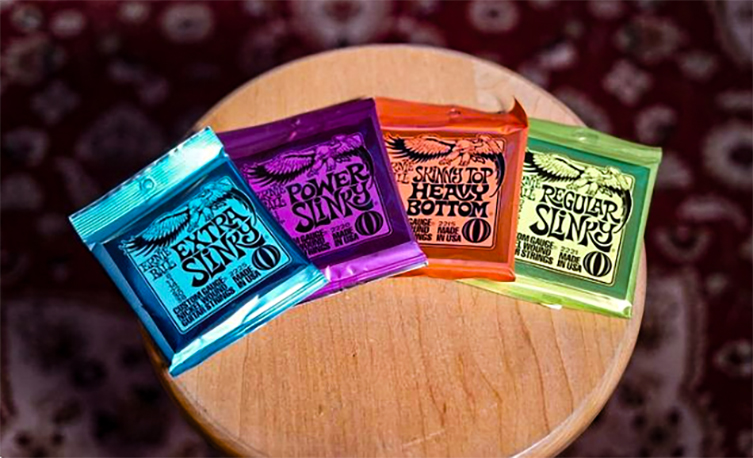
For full fan-service, let me give you his exact string gauges:
- D#/Eb tuning: .008, .008, .011, .018w, .024, .032
- C# tuning: .009, .010, .012, .020w, .032, .042
So that’s what Tony uses. You know what, though? See unless you really want to do nothing on your guitar except play super-accurate Sabbath riffs, I actually don’t recommend copying Tony on this one. Through experience, I’ve found that there is so little tension available - even the gauge 8s tuned a half step down, far less the C# stuff - that you will sound very out of pitch and out of tune unless you are extremely careful with how you play.
I’ll talk more about that in just a sec, but if you want to have a comfortable instrument that intones properly in tunings like C#, I’d still recommend going up to a set of gauge 11-52 or even 12-56 strings, depending on your preferences and your guitar’s scale length. Authenticity is one thing, but sounding deliberately out of tune isn’t clever. Tony hasn’t got much choice due to his old injury, but you can get close enough without sacrificing tuning stability and intonation!
Use a Light Touch
- Compensate for light strings and low tuning by playing delicately
- Slight dissonance = good, out of tune = bad
Due to Tony’s damaged fingertips and subsequent replacement tips, he tends to use a very light touch when playing. This is also of course due to how light his guitar strings are and how low they are tuned: there’s just no room to be heavy-handed! Pressing down harder with his right hand (which is Tony’s fretting hand since he’s a lefty) would hurt his fingers and also push his notes sharp. Not what’s wanted!
This is true also of his picking hand. Tony does not seem to dig in with this one either, but instead plays with a very light attack, using only medium-heavy picks (Dunlop Tortex .88mm). This is again because of intonation issues brought on by the light string/low tuning combo. Striking the strings hard would ‘boing’ the string too much, and whilst a certain pitch dissonance is required for the signature Sabbath heaviness, those notes still need to sound out true to pitch!
I mentioned earlier that Tony lets his amps ‘do most of the work’ and this is where it proves clever: he isn’t battering the guitar to make it sound huge, he is playing a huge guitar sound very softly. The heaviness translates completely. This is a good lesson for all metal players, actually: you don’t have to play hard to sound hard. Take an example from uncle Tony.
Black Sabbath Playing Tips
- Play up the neck, not across the strings
- Keep it simple, but not too simple
- Employ light and shade
- Super-Wide Vibrato
- Don’t overuse a riff
Finally, here are some observations I’ve made on how Tony seems to approach the art of riff writing. These are my reflections on being a life-long Sabbath fan, and may prove useful in helping you approach your own riff-writing.
- Play up the neck, not across the strings: lots of Tony’s riffs focus on the bottom two strings, with his fingers sliding up and down the frets rather than going across all six strings laterally. In other words, his hands move more often to keep his chosen notes on the lower strings. For example, Tony plays Paranoid at the 12-14th frets, not the 7-9 frets, if you get me?
- Keep it simple, but not too simple: most of the greatest Sabbath riffs strike a fine balance between being simple, catchy, accessible to the ear and easy to remember. Some are quite ‘monolithic’ (War Pigs, Hole in the Sky) and others have more notes (Snowblind, Into the Void), but none of them are overly complex or full of unnecessary notes.
- Employ light and Shade: Tony is good at using contrast to add colour and variation to his writing. Whether that’s switching from single notes to chords (Sabbath Bloody Sabbath), juxtaposing low notes with higher register ones (War Pigs) or having acoustic sections (Killing Yourself to Live), there’s lots of textural light and shade employed.
- Super-Wide Vibrato: Tony often applies a particularly wide vibrato to his parts. Just listen to the intro to Wheels of Confusion for an instant example. This is no doubt another byproduct of the low tuning/light strings situation, since there will be loads of loose movement available in Tony’s strings. You can apply this to your playing in the normal manner, by employing a strong, wide up & down vibrato to certain notes, though not too many of it’ll detract from your overall effect and your listeners will get seasick!
- Don’t Overuse a Riff: Tony rarely stays on a single riff or part for too long, and he rarely overuses any section within a song. Part of Sabbath’s genius is in the proliferation of great riffs, all inside the same tune. Check out anything from Sabotage or Volume 4 and you’ll hear an excellent intro riff, a great verse riff and another great riff all within the first minute and a half of any given song. Tomorrow’s Dream is a prime example. Lots of Sabbath copycat bands either haven’t picked up on that or can’t do it, but it’s singular to the band’s appeal.
For more, check out my blog on the Best Ever Black Sabbath Riffs!
There’s Only One Black Sabbath
It’s sad to think that, after this summer, Black Sabbath will likely never play again. If you are like me - a fan who doesn’t have a ticket to the show - then the whole event is a bittersweet one. We are glad to see the band get the recognition and adulation that they deserve and command, but it’s right at the end of it all, when the final curtain is coming down, never to be raised again.
At least we have over half a century’s worth of epic music to listen to again and again, though! That’s not going anywhere, and I hope that today’s look into Tony Iommi’s mighty guitar sound and approach to playing has helped you get a little closer to that immortal sound yourself. Thanks for reading, and don’t forget about that protective magic circle!

